English worksheets > contributions by bmcq
|
The author |
|

bmcq
Barbara McQueen

|
3 decades of mentoring fellow teachers one-on-one, through in-services, as an ESL teacher trainer for Oxford Seminars, and as a conference presenter for TESOL, the VWBPE, SLanguages, and MachinEVO. Currently developing and delivering immersive online ESL courses in the virtual world known as Second Life that make use of situational role-playing, games, mysteries, machinima, and special events.
Points: 1036
|
|
order results:
newest first -
most downloaded first
-
alphabetically -
random order |
|
Printables |
PowerPoints |
Online exercises |
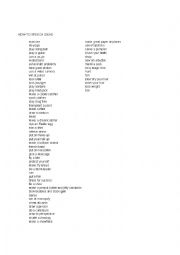
|
How-To Speech Ideas, Requirements, and Models
It is appropriate to teach some public speaking skills to ESL students in addition to conversation practice. The easiest first speech is a how-to speech since it is usually relatively short and uses visual aids that help keep the speaker focused and give the audience something to stare at besides the speaker. In this file there are a list of many...
Level: intermediate
Age: 12-100
Type: activity-card
Downloads: 10
|
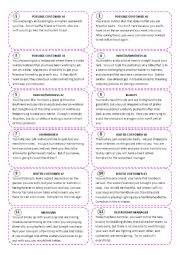
|
Restaurant Roleplay Cards
12 roleplay cards for issues that could arise related to restaurants, plus a map of where to place students for the roleplays. Give all the students their cards privately and circulate to answer any questions. Students should not show their cards to each other. Then have the students outside the restaurant start the roleplay. Once they have been...
Level: intermediate
Age: 18-100
Type: activity-card
Downloads: 92
|
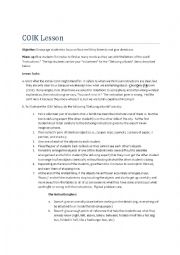
|
COIK Lesson
COIK stands for "Clear Only If Known" which is, unfortunately, how many of us feel when someone gives us poor directions and then says, "You can�t miss it." To improve my students� direction-giving abilities, I tell them they must defuse a bomb by phone. I put the students back-to-back, and the expert who is supposedly on the other side of the ci...
Level: intermediate
Age: 12-100
Type: lesson-plan
Downloads: 13
|
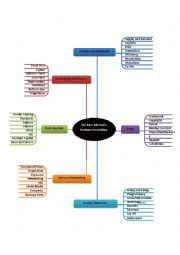
|
Bare Minimum Business Lingo
Five categories of business terms that are a good starting point for determining what students already know and what they need to learn for doing international business. The five categories are Business Management, Accounting and Finance, Legal, Stock Markets, and Human Resources. This could be used with high intermediate or advanced ESL students.
Level: advanced
Age: 16-100
Type: worksheet
Downloads: 19
|
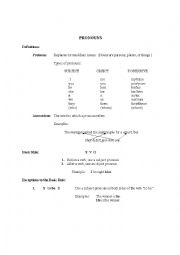
|
Five Pronoun Rules, Pronoun Exercises, and a Pronoun Auction
There are many rules related to pronoun usage in English. I�ve simplified the most common rules into one basic rule with four exceptions and come up with an auction activity to cement these rules into memories. The basic pronoun rule covers 90 of all pronoun usage. Exceptions, in general, drive students crazy. But tell the students that they sh...
Level: elementary
Age: 10-100
Type: lesson-plan
Downloads: 5
|
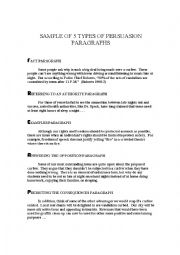
|
Five Types of Persuasion
You can tell students to vary the types of persuasion they use in essays, but they often get in ruts or simply don�t quite understand. So I find it useful to take one topic and give them five paragraphs on it, with each paragraph representing a different type of persuasion. On this handout, I�ve done that on the topic of imposing a teen curfew.
Level: advanced
Age: 12-100
Type: article
Downloads: 32
|
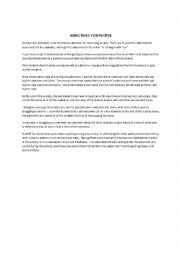
|
Adjectives for People
An extensive alphabetical list of positive adjectives for describing people. There are at least five adjectives for every letter of the alphabet, although the adjectives for the letter �x� all begin with �ex.�
I use this as a tool to help students with a getting-to-know-you exercise where they must think of an adjective that describes themse...
Level: intermediate
Age: 12-100
Type: activity-card
Downloads: 14
|

|
Tongue Twisters
A collection of 45 tongue twisters on a one-page handout plus several charts showing which sounds or sound contrasts are particularly troublesome for speakers of different languages. Often the problem for our ELL students is that English has sounds that don�t exist in the students� native language, so a list is included in this file of those Englis...
Level: intermediate
Age: 10-100
Type: activity-card
Downloads: 61
|
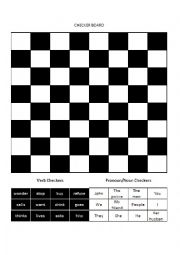
|
Subject/Verb Agreement Checkers
Grammar meets checkers. The students can only jump opponents� checkers if there is subject/verb agreement between the pieces involved in the jump. For example, a checker with "he" on it can jump a checker with "writes" on it, but not a checker with "write" on it. Students will have to pay close attention to any s�s they see.
Level: elementary
Age: 5-100
Type: activity-card
Downloads: 25
|
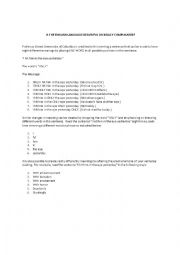
|
Intonation Practice
A handout to walk students through making recordings that help them understand how stress and emotion can change the meaning of a sentence.
Level: intermediate
Age: 10-100
Type: worksheet
Downloads: 5
|
|
|
|
|